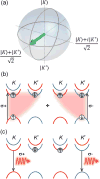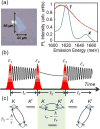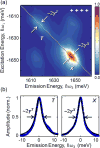Trion Valley Coherence in Monolayer Semiconductors
- PMID: 28924488
- PMCID: PMC5600293
- DOI: 10.1088/2053-1583/aa70f9
Trion Valley Coherence in Monolayer Semiconductors
Abstract
The emerging field of valleytronics aims to exploit the valley pseudospin of electrons residing near Bloch band extrema as an information carrier. Recent experiments demonstrating optical generation and manipulation of exciton valley coherence (the superposition of electron-hole pairs at opposite valleys) in monolayer transition metal dichalcogenides (TMDs) provide a critical step towards control of this quantum degree of freedom. The charged exciton (trion) in TMDs is an intriguing alternative to the neutral exciton for control of valley pseudospin because of its long spontaneous recombination lifetime, its robust valley polarization, and its coupling to residual electronic spin. Trion valley coherence has however been unexplored due to experimental challenges in accessing it spectroscopically. In this work, we employ ultrafast two-dimensional coherent spectroscopy to resonantly generate and detect trion valley coherence in monolayer MoSe2 demonstrating that it persists for a few-hundred femtoseconds. We conclude that the underlying mechanisms limiting trion valley coherence are fundamentally different from those applicable to exciton valley coherence.
Keywords: transition-metal dichalcogenides; trions; two-dimensional coherent spectroscopy; valley coherence.
Figures




References
-
- Jones AM, Yu H, Ghimire NJ, Wu S, Aivazian G, Ross JS, Zhao B, Yan J, Mandrus DG, Xiao D, Yao W, Xu X. Nat Nanotech. 2013;8:634. - PubMed
-
- Hao K, Moody G, Wu F, Dass CK, Xu L, Chen CH, Sun L, Li MY, Li LJ, MacDonald AH, Li X. Nat Phys. 2016;12:677.
-
- Wang G, Glazov MM, Robert C, Amand T, Marie X, Urbaszek B. Phys Rev Lett. 2015;115:117401. - PubMed
-
- Wang G, Marie X, Gerber I, Amand T, Lagarde D, Bouet L, Vidal M, Balocchi A, Urbaszek B. Phys Rev Lett. 2015;114:097403. - PubMed
-
- Wang G, Marie X, Liu BL, Amand T, Robert C, Cadiz F, Renucci P, Urbaszek B. Phys Rev Lett. 2016;117:187401. - PubMed
Grants and funding
LinkOut - more resources
Full Text Sources
Other Literature Sources
